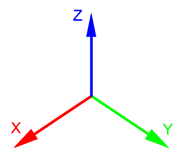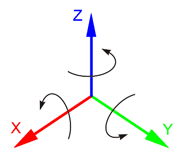1. Basic Scene Objects and Coordinate System
Basic Scene Objects
In terms of UNIGINE, node is a basic type from which all types of scene objects are inherited. Some of them appear visually: Objects, Decals, and Effects they all have surfaces to represent their geometry (mesh), while others (Light Sources, Players, etc.) are invisible.
Each node has a transformation matrix, which encodes position, rotation, and scale of the node in the world.
All scene objects added to the scene regardless of their type are called nodes.
Coordinate System
The 3D space in Unigine is represented by the right-handed Cartesian coordinate system: X and Y axes form a horizontal plane, Z axis points up. When exporting an animation from 3D editors, Y is considered a forward direction.

Positive rotation angle sets the rotation counterclockwise. It corresponds to the right-hand rule: if you set right hand thumb along the axis, other fingers wrapped will show rotation direction.

Additional information:
- For more information on UNIGINE node types, see Built-in Node Types page.
- For more information on managing nodes via API, see Nodes classes page.